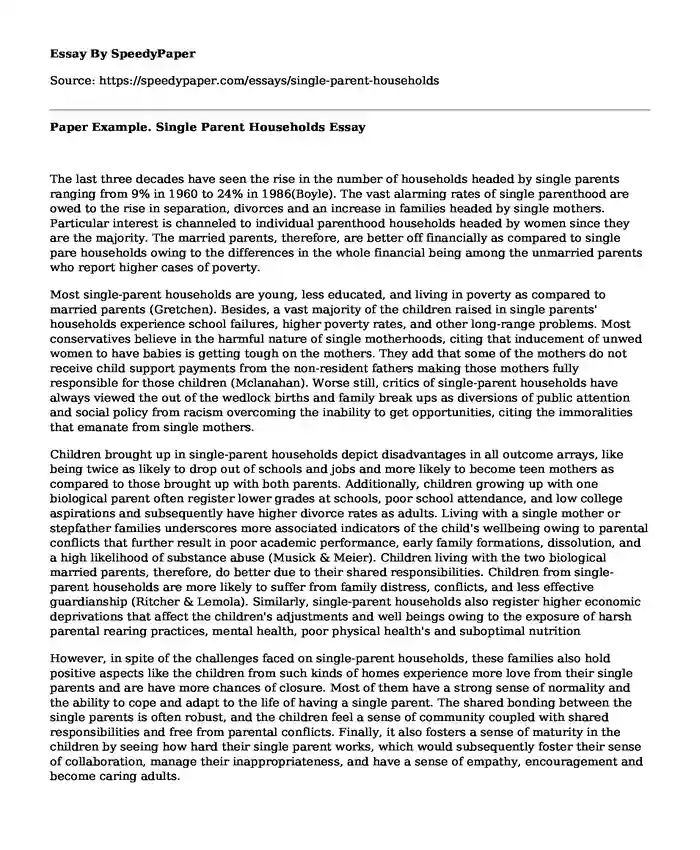
| Type of paper: | Essay |
| Categories: | Parenting Relationship Social psychology Social issue |
| Pages: | 3 |
| Wordcount: | 658 words |
The last three decades have seen the rise in the number of households headed by single parents ranging from 9% in 1960 to 24% in 1986(Boyle). The vast alarming rates of single parenthood are owed to the rise in separation, divorces and an increase in families headed by single mothers. Particular interest is channeled to individual parenthood households headed by women since they are the majority. The married parents, therefore, are better off financially as compared to single pare households owing to the differences in the whole financial being among the unmarried parents who report higher cases of poverty.
Most single-parent households are young, less educated, and living in poverty as compared to married parents (Gretchen). Besides, a vast majority of the children raised in single parents' households experience school failures, higher poverty rates, and other long-range problems. Most conservatives believe in the harmful nature of single motherhoods, citing that inducement of unwed women to have babies is getting tough on the mothers. They add that some of the mothers do not receive child support payments from the non-resident fathers making those mothers fully responsible for those children (Mclanahan). Worse still, critics of single-parent households have always viewed the out of the wedlock births and family break ups as diversions of public attention and social policy from racism overcoming the inability to get opportunities, citing the immoralities that emanate from single mothers.
Children brought up in single-parent households depict disadvantages in all outcome arrays, like being twice as likely to drop out of schools and jobs and more likely to become teen mothers as compared to those brought up with both parents. Additionally, children growing up with one biological parent often register lower grades at schools, poor school attendance, and low college aspirations and subsequently have higher divorce rates as adults. Living with a single mother or stepfather families underscores more associated indicators of the child's wellbeing owing to parental conflicts that further result in poor academic performance, early family formations, dissolution, and a high likelihood of substance abuse (Musick & Meier). Children living with the two biological married parents, therefore, do better due to their shared responsibilities. Children from single-parent households are more likely to suffer from family distress, conflicts, and less effective guardianship (Ritcher & Lemola). Similarly, single-parent households also register higher economic deprivations that affect the children's adjustments and well beings owing to the exposure of harsh parental rearing practices, mental health, poor physical health's and suboptimal nutrition
However, in spite of the challenges faced on single-parent households, these families also hold positive aspects like the children from such kinds of homes experience more love from their single parents and are have more chances of closure. Most of them have a strong sense of normality and the ability to cope and adapt to the life of having a single parent. The shared bonding between the single parents is often robust, and the children feel a sense of community coupled with shared responsibilities and free from parental conflicts. Finally, it also fosters a sense of maturity in the children by seeing how hard their single parent works, which would subsequently foster their sense of collaboration, manage their inappropriateness, and have a sense of empathy, encouragement and become caring adults.
Works Cited
Boyle, Maureen. "Spending Patterns and Incomes of Single and Married Families." U.S. Bureau
Of Labor Statistics, Research Summaries, Mar. 1989, www.bls.org
Gretchen, Livingston "The Changing Profile of Unmarried Parents." Pew Research Center, 25
Apr. 2018, www.pewsocialtrends.org
McLanahan, Sara. "The Consequences of Single Motherhood." The American Prospect, 19 Dec.2001, www.prospect.org
Musick, Kelly, and Ann, Meier. "Are Both Parents Always Better than One? Parental Conflict and Young Adult Well-Being." Social Science Research, U.S. National Library ofMedicine, Sept. 2010, www.ncbi.nlm.nih.gov
Richter, David, and Sakari, Lemola. "Growing up with a Single Mother and Life Satisfaction in
Adulthood: A Test of Mediating and Moderating Factors." PLOS ONE, Public Library of Science, 15 June 2017, www.journals.plos.org
Cite this page
Paper Example. Single Parent Households. (2023, Mar 04). Retrieved from https://speedypaper.com/essays/single-parent-households
Request Removal
If you are the original author of this essay and no longer wish to have it published on the SpeedyPaper website, please click below to request its removal:
- Free Essay with Tips on Writing a Thesis
- Free Essay on Peer Pressure in Today's Society
- Shame and I Became Her Target - Essays Analysis Example
- Essay Example on Art Movement and Graphic Design
- Samoan Culture, Free Essay Example
- Essay Sample: Michael Jackson Addiction to Demerol and Narcotics
- Essay Sample on Duality in Religion
Popular categories




